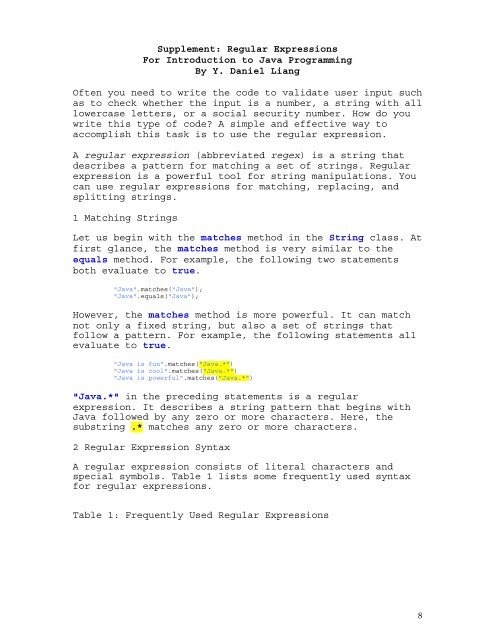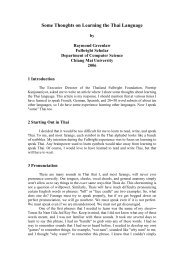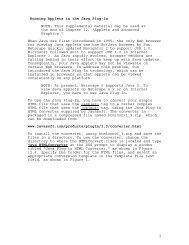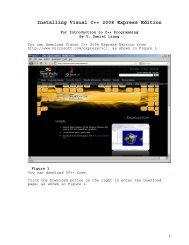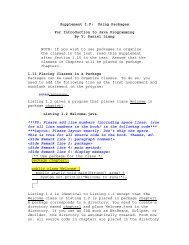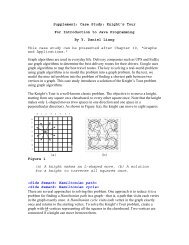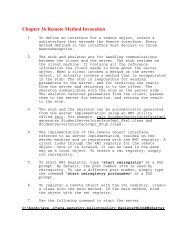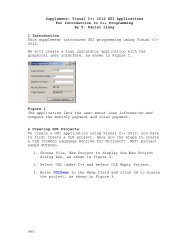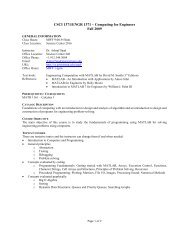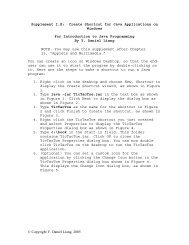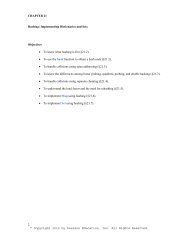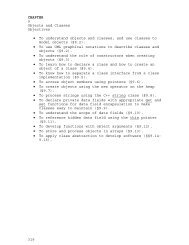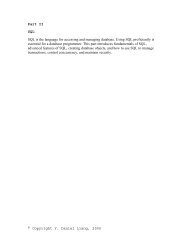Supplement: Regular Expressions For Introduction to Java ...
Supplement: Regular Expressions For Introduction to Java ...
Supplement: Regular Expressions For Introduction to Java ...
Create successful ePaper yourself
Turn your PDF publications into a flip-book with our unique Google optimized e-Paper software.
<strong>Supplement</strong>: <strong>Regular</strong> <strong>Expressions</strong><br />
<strong>For</strong> <strong>Introduction</strong> <strong>to</strong> <strong>Java</strong> Programming<br />
By Y. Daniel Liang<br />
Often you need <strong>to</strong> write the code <strong>to</strong> validate user input such<br />
as <strong>to</strong> check whether the input is a number, a string with all<br />
lowercase letters, or a social security number. How do you<br />
write this type of code? A simple and effective way <strong>to</strong><br />
accomplish this task is <strong>to</strong> use the regular expression.<br />
A regular expression (abbreviated regex) is a string that<br />
describes a pattern for matching a set of strings. <strong>Regular</strong><br />
expression is a powerful <strong>to</strong>ol for string manipulations. You<br />
can use regular expressions for matching, replacing, and<br />
splitting strings.<br />
1 Matching Strings<br />
Let us begin with the matches method in the String class. At<br />
first glance, the matches method is very similar <strong>to</strong> the<br />
equals method. <strong>For</strong> example, the following two statements<br />
both evaluate <strong>to</strong> true.<br />
"<strong>Java</strong>".matches("<strong>Java</strong>");<br />
"<strong>Java</strong>".equals("<strong>Java</strong>");<br />
However, the matches method is more powerful. It can match<br />
not only a fixed string, but also a set of strings that<br />
follow a pattern. <strong>For</strong> example, the following statements all<br />
evaluate <strong>to</strong> true.<br />
"<strong>Java</strong> is fun".matches("<strong>Java</strong>.*")<br />
"<strong>Java</strong> is cool".matches("<strong>Java</strong>.*")<br />
"<strong>Java</strong> is powerful".matches("<strong>Java</strong>.*")<br />
"<strong>Java</strong>.*" in the preceding statements is a regular<br />
expression. It describes a string pattern that begins with<br />
<strong>Java</strong> followed by any zero or more characters. Here, the<br />
substring .* matches any zero or more characters.<br />
2 <strong>Regular</strong> Expression Syntax<br />
A regular expression consists of literal characters and<br />
special symbols. Table 1 lists some frequently used syntax<br />
for regular expressions.<br />
Table 1: Frequently Used <strong>Regular</strong> <strong>Expressions</strong><br />
8
<strong>Regular</strong> Expression Matches Example<br />
x a specified character x <strong>Java</strong> matches <strong>Java</strong><br />
. any single character <strong>Java</strong> matches J..a<br />
(ab|cd) ab or cd ten matches t(en|im)<br />
[abc] a, b, or c <strong>Java</strong> matches Ja[uvwx]a<br />
[^abc] any character except <strong>Java</strong> matches Ja[^ars]a<br />
a, b, or c<br />
[a-z] a through z <strong>Java</strong> matches [A-M]av[a-d]<br />
[^a-z] any character except <strong>Java</strong> matches Jav[^b-d]<br />
a through z<br />
[a-e[m-p]] a through e or <strong>Java</strong> matches<br />
m through p<br />
[A-G[I-M]]av[a-d]<br />
[a-e&&[c-p]] intersection of a-e <strong>Java</strong> matches<br />
with c-p<br />
[A-P&&[I-M]]av[a-d]<br />
\d a digit, same as [0-9] <strong>Java</strong>2 matches "<strong>Java</strong>[\\d]"<br />
\D a non-digit $<strong>Java</strong> matches "[\\D][\\D]ava"<br />
\w a word character <strong>Java</strong>1 matches "[\\w]ava[\\w]"<br />
\W a non-word character $<strong>Java</strong> matches "[\\W][\\w]ava"<br />
\s a whitespace character "<strong>Java</strong> 2" matches "<strong>Java</strong>\\s2"<br />
\S a non-whitespace char <strong>Java</strong> matches "[\\S]ava"<br />
p* zero or more <strong>Java</strong> matches "a*"<br />
occurrences of pattern p bbb matches "a*"<br />
p+ one or more <strong>Java</strong> matches "a+"<br />
occurrences of pattern p bbb matches "a+"<br />
p? zero or one <strong>Java</strong> matches "J?<strong>Java</strong>"<br />
occurrence of pattern p ava matches "J?ava"<br />
p{n} exactly n <strong>Java</strong> matches "a{1}"<br />
occurrences of pattern p <strong>Java</strong> does not match "a{2}"<br />
p{n,} at least n <strong>Java</strong> matches "a{1,}"<br />
occurrences of pattern p <strong>Java</strong> does not match "a{2,}"<br />
p{n,m} between n and m <strong>Java</strong> matches "a{1,9}"<br />
occurrences (inclusive) <strong>Java</strong> does not match "a{2,9}"<br />
NOTE<br />
Backslash is a special character that starts an<br />
escape sequence in a string. So you need <strong>to</strong> use<br />
"\\d" in <strong>Java</strong> <strong>to</strong> represent \d.<br />
NOTE<br />
Recall that a whitespace (or a whitespace<br />
character) is any character which does not<br />
display itself but does take up space. The<br />
characters ' ', '\t', '\n', '\r', '\f' are<br />
whitespace characters. So \s is the same as [<br />
\t\n\r\f], and \S is the same as [^ \t\n\r\f\v].<br />
NOTE<br />
A word character is any letter, digit, or the<br />
underscore character. So \w is the same as [az[A-Z][0-9]_]<br />
or simply [a-zA-Z0-9_], and \W is<br />
the same as [^a-zA-Z0-9_].<br />
NOTE<br />
9
The last six entries *, +, ?, {n}, {n,}, and {n,<br />
m} in Table 1 are called quantifiers that<br />
specify how many times the pattern before a<br />
quantifier may repeat. <strong>For</strong> example, A* matches<br />
zero or more A’s, A+ matches one or more A’s, A?<br />
matches zero or one A’s, A{3} matches exactly<br />
AAA, A{3,} matches at least three A’s, and<br />
A{3,6} matches between 3 and 6 A’s. * is the<br />
same as {0,}, + is the same as {1,}, and ? is the<br />
same as {0,1}.<br />
CAUTION<br />
Do not use spaces in the repeat quantifiers. <strong>For</strong><br />
example, A{3,6} cannot be written as A{3, 6}<br />
with a space after the comma.<br />
NOTE<br />
You may use parentheses <strong>to</strong> group patterns. <strong>For</strong><br />
example, (ab){3} matches ababab, but ab{3}<br />
matches abbb.<br />
Let us use several examples <strong>to</strong> demonstrate how <strong>to</strong> construct<br />
regular expressions.<br />
Example 1: The pattern for social security numbers is xxxxx-xxxx,<br />
where x is a digit. A regular expression for social<br />
security numbers can be described as<br />
<strong>For</strong> example,<br />
[\\d]{3}-[\\d]{2}-[\\d]{4}<br />
"111-22-3333".matches("[\\d]{3}-[\\d]{2}-[\\d]{4}") returns true.<br />
"11-22-3333".matches("[\\d]{3}-[\\d]{2}-[\\d]{4}") returns false.<br />
Example 2: An even number ends with digits 0, 2, 4, 6, or 8.<br />
The pattern for even numbers can be described as<br />
[\\d]*[02468]<br />
<strong>For</strong> example,<br />
"123".matches("[\\d]*[02468]") returns false.<br />
"122".matches("[\\d]*[02468]") returns true.<br />
Example 3: The pattern for telephone numbers is (xxx) xxxxxxx,<br />
where x is a digit and the first digit cannot be zero.<br />
A regular expression for telephone numbers can be described<br />
as<br />
\\([1-9][\\d]{2}\\) [\\d]{3}-[\\d]{4}<br />
10
Note that the parentheses symbols ( and ) are special<br />
characters in a regular expression for grouping patterns. To<br />
represent a literal ( or ) in a regular expression, you have<br />
<strong>to</strong> use \\( and \\).<br />
<strong>For</strong> example,<br />
"(912) 921-2728".matches("\\([1-9][\\d]{2}\\) [\\d]{3}-[\\d]{4}") returns true.<br />
"921-2728".matches("\\([1-9][\\d]{2}\\) [\\d]{3}-[\\d]{4}") returns false.<br />
Example 4: Suppose the last name consists of at most 25<br />
letters and the first letter is in uppercase. The pattern<br />
for a last name can be described as<br />
[A-Z][a-zA-Z]{1,24}<br />
Note that you cannot have arbitrary whitespace in a regular<br />
expression. <strong>For</strong> example, [A-Z][a-zA-Z]{1, 24} would be<br />
wrong.<br />
<strong>For</strong> example,<br />
"Smith".matches("[A-Z][a-zA-Z]{1,24}") returns true.<br />
"Jones123".matches("[A-Z][a-zA-Z]{1,24}") returns false.<br />
Example 5: <strong>Java</strong> identifiers are defined in §2.3,<br />
“Identifiers.”<br />
<br />
<br />
An identifier must start with a letter, an underscore<br />
(_), or a dollar sign ($). It cannot start with a<br />
digit.<br />
An identifier is a sequence of characters that consists<br />
of letters, digits, underscores (_), and dollar signs<br />
($).<br />
The pattern for identifiers can be described as<br />
[a-zA-Z_$][\\w$]*<br />
Example 6: What strings are matched by the regular<br />
expression "Welcome <strong>to</strong> (<strong>Java</strong>|HTML)"? The answer is Welcome<br />
<strong>to</strong> <strong>Java</strong> or Welcome <strong>to</strong> HTML.<br />
Example 7: What strings are matched by the regular<br />
expression ".*"? The answer is any string.<br />
3 Replacing and Splitting Strings<br />
The matches method in the String class returns true if the<br />
string matches the regular expression. The String class also<br />
contains the replaceAll, replaceFirst, and split methods for<br />
replacing and splitting strings, as shown in Figure 1.<br />
11
java.lang.String<br />
+matches(regex: String): boolean<br />
+replaceAll(regex: String, replacement:<br />
String): String<br />
+replaceFirst(regex: String,<br />
replacement: String): String<br />
+split(regex: String): String[]<br />
+split(regex: String, limit: int): String[]<br />
Returns true if this string matches the pattern.<br />
Returns a new string that replaces all matching substrings with<br />
the replacement.<br />
Returns a new string that replaces the first matching substring<br />
with the replacement.<br />
Returns an array of strings consisting of the substrings split by<br />
the matches.<br />
Same as the preceding split method except that the limit<br />
parameter controls the number of times the pattern is applied.<br />
Figure 1<br />
The String class contains the methods for matching,<br />
replacing, and splitting strings using regular expressions.<br />
The replaceAll method replaces all matching substring and<br />
the replaceFirst method replaces the first matching<br />
substring. <strong>For</strong> example, the following code<br />
displays<br />
System.out.println("<strong>Java</strong> <strong>Java</strong> <strong>Java</strong>".replaceAll("v\\w", "wi"));<br />
Jawi Jawi Jawi<br />
The following code<br />
displays<br />
System.out.println("<strong>Java</strong> <strong>Java</strong> <strong>Java</strong>".replaceFirst("v\\w", "wi"));<br />
Jawi <strong>Java</strong> <strong>Java</strong><br />
There are two overloaded split methods. The split(regex)<br />
method splits a string in<strong>to</strong> substrings delimited by the<br />
matches. <strong>For</strong> example, the following statement<br />
String[] <strong>to</strong>kens = "<strong>Java</strong>1HTML2Perl".split("\\d");<br />
splits string "<strong>Java</strong>1HTML2Perl" in<strong>to</strong> <strong>Java</strong>, HTML, and Perl and<br />
saved in <strong>to</strong>kens[0], <strong>to</strong>kens[1], and <strong>to</strong>kens[2].<br />
In the split(regex, limit) method, the limit parameter<br />
determines how many times the pattern is matched. If limit<br />
0, the pattern is matched at most limit – 1 times. Here<br />
are some examples:<br />
"<strong>Java</strong>1HTML2Perl".split("\\d", 0); splits in<strong>to</strong> <strong>Java</strong>, HTML, Perl<br />
"<strong>Java</strong>1HTML2Perl".split("\\d", 1); splits in<strong>to</strong> <strong>Java</strong>1HTML2Perl<br />
"<strong>Java</strong>1HTML2Perl".split("\\d", 2); splits in<strong>to</strong> <strong>Java</strong>, HTML2Perl<br />
"<strong>Java</strong>1HTML2Perl".split("\\d", 3); splits in<strong>to</strong> <strong>Java</strong>, HTML, Perl<br />
"<strong>Java</strong>1HTML2Perl".split("\\d", 4); splits in<strong>to</strong> <strong>Java</strong>, HTML, Perl<br />
"<strong>Java</strong>1HTML2Perl".split("\\d", 5); splits in<strong>to</strong> <strong>Java</strong>, HTML, Perl<br />
12
NOTE:<br />
By default, all the quantifiers are greedy. This<br />
means that they will match as many occurrences<br />
as possible. <strong>For</strong> example, the following<br />
statement displays JRvaa, since the first match<br />
is aaa.<br />
System.out.println("Jaaavaa".replaceFirst("a+", "R"));<br />
You can change a qualifier’s default behavior by<br />
appending a question mark (?) after it. The<br />
quantifier becomes reluctant, which means that<br />
it will match as few occurrences as possible.<br />
<strong>For</strong> example, the following statement displays<br />
JRaavaa, since the first match is a.<br />
System.out.println("Jaaavaa".replaceFirst("a+?", "R"));<br />
13


